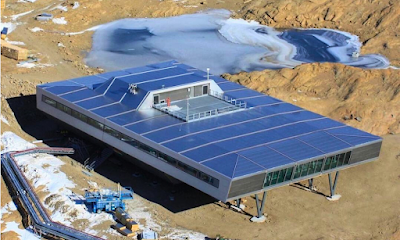
Indian specialists at Bharati, a long-lasting Antarctic exploration station charged by India, have followed Ionospheric mysteries in the southernmost landmass that can help satellite-based route.
The Ionosphere is essential for Earth's upper air, among 80 and around 600 km where Outrageous Bright (EUV) and x-beam sun powered radiation ionizes the iotas and particles hence making a layer of electrons.
The ionosphere is significant on the grounds that it reflects and adjusts radio waves utilized for correspondence and route
Very long term ionospheric perceptions at Bharati station, Antarctica, found a significant occasional variety with greatest complete electron count (Detective) in equinoctial months followed by the mid year and winter. The Sleuth is a key boundary that is utilized to comprehend the impacts of ionosphere on satellite-based route and correspondence signals.

Such long haul studies can assist with grasping impacts of ionosphere on satellite-based route and correspondence frameworks and to moderate them.
The ionosphere at polar locales is profoundly powerful and goes about as a significant energy sink for space climate occasions, and related processes in magnetosphere-ionosphere frameworks as the attractive field lines are upward around here. The ionospheric perceptions in Antarctica are not many contrasted with Cold locale because of geographic limits and predetermined number of stations.

A group of researchers from the Indian Establishment of Geomagnetism (IIG), an independent body of the Branch of Science and Innovation (DST) have inspected the drawn out occasional ionospheric perceptions at Indian Antarctica station Bharati somewhere in the range of 2010 and 2022 and furthermore with sun based movement following Sun's 11-year cycle.
it was seen that however there was no daylight frequency over the course of the day in cold weather months (polar evenings) at Bharati station; a diurnal example was seen with top ionospheric thickness close to neighborhood early afternoon. The day-night ionospheric thickness varieties were noticed paying little mind to 24 hours of daylight in summer and complete obscurity in winter. The researchers credited the pinnacle ionization to molecule precipitation and transportation of convectional plasma from high scopes. Likewise, the most extreme ionospheric thickness in the late spring months where 24 hours daylight is available (polar days), was about two times more than that of polar evenings at the Bharati locale.
The review was distributed in the Diary of Polar Science. This sort of long haul studies will assist with grasping impacts of ionosphere on satellite-based route and correspondence frameworks and to moderate them.




No comments:
Post a Comment